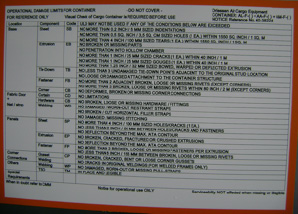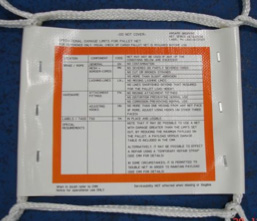Basics, Cargo Terminals, Freight Forwarders, CARE, Ground Handlers, Continuing Airworthiness, ULD Service providers, Safety
Checking a ULD for damage
It is quite likely that many readers of the ULD CARE newsletter will have observed, at some time or other, the “walk around” inspection carried out by one of the flight crew on an aircraft while parked at the gate before passenger boarding. This visual inspection which must be carried out tens of thousands of times a day at thousands of airports by countless flight-deck crew is an essential part of flight safety and one that can never be ignored.
As a piece of aircraft equipment, any ULD is subject to the same requirement, that it be visually inspected before being loaded to the aircraft. The accurate and consistent compliance with this requirement is a key component to safe air cargo operations.
ULD damage can take many forms. From the totally wrecked container to a cargo net with a broken braid, damages can be large or small, easy or difficult to spot. The trick to carrying out efficient and effective inspections of any ULD requires that the person carrying out the check is familiar with the sort of items he is looking for and knows how to determine if any damage found is outside the allowable limits for that ULD.

Large and conspicuous damage is easy enough to detect and there would be no question that a ULD in this condition would not be acceptable for use. Harder to detect are the smaller damages that are either not so visible or fall somewhere on the borderline between serviceable and unserviceable.
Damage that is not so visible would include items such as
- small cracks in extrusions or brackets
- missing fasteners such as rivets
- broken or badly chafed braid on a cargo net
Ideally these types of damages will have been detected before the ULD is built up, as this is the ideal time to carry out such an inspection. But this is not always the case and anyway there is a requirement to carry out a final check of the ULD just prior to loading it onto the aircraft. It is therefore in both the interest of safety and also in pursuit of efficient operations that whether the check is carried out before build up or just prior to loading onto the aircraft, that the check is carried out with sufficient diligence and attention so that even the smallest damage is at least noticed and that nothing is assumed to be OK.
Of course, carrying out such checks on a nice sunny day with no time pressure is one thing; carrying it out at night, maybe in the pouring rain, under time pressure is another. But just as you would not wish to set off in your car with a half inflated tire neither should you wish to allow a damaged ULD to be loaded on board an aircraft.
 One of the biggest obstacles to comprehensive checking of ULD has been the varying requirements of different airlines, and different types of ULD. The ground handling industry has been presented with a very difficult task when it comes to meeting their responsibility that only serviceable ULD are used. In response to this challenging situation, IATA developed and published the Operational Damage Limits Notice (ODLN) as standard specification 40/3 in section 7 of the IATA ULD Regulations. (Newsletter # 3 from ULD CARE introduced this item).
One of the biggest obstacles to comprehensive checking of ULD has been the varying requirements of different airlines, and different types of ULD. The ground handling industry has been presented with a very difficult task when it comes to meeting their responsibility that only serviceable ULD are used. In response to this challenging situation, IATA developed and published the Operational Damage Limits Notice (ODLN) as standard specification 40/3 in section 7 of the IATA ULD Regulations. (Newsletter # 3 from ULD CARE introduced this item).
This notice which is now required on all newly delivered ULD can now be seen on a majority of ULD in use today,  which includes not just containers but also pallets, cargo nets, and certified cargo straps. The concept behind this standardized damage limits notice is that while different designs of a ULD may have different damage limitations, the basic components of any particular type of ULD are rather similar. For example, they will all have a base, or a door etc. The damage limits notice provides a framework of different items requiring checking into which ULD manufacturer can insert the limitations that are specific to his design.
which includes not just containers but also pallets, cargo nets, and certified cargo straps. The concept behind this standardized damage limits notice is that while different designs of a ULD may have different damage limitations, the basic components of any particular type of ULD are rather similar. For example, they will all have a base, or a door etc. The damage limits notice provides a framework of different items requiring checking into which ULD manufacturer can insert the limitations that are specific to his design.
Now this may all seem rather long-winded and time-consuming and not applicable in a fast moving deadline sensitive cargo operation. However, that would be an incorrect assumption. Inspecting a piece of ULD needs to take no more than the time it takes to walk around all four sides of the device, and this kind of check can be carried out in a very short time. It is only when any damage is found that it may become necessary to spend a little more time, looking more closely at the damage, then making reference to the ODLN to check if indeed the damage is beyond the acceptable limit.
Another consideration, indeed one that is not that unlikely, is that during the inspection some kind of incorrect “on the spot” repair work has been carried out, such as sticky tape to patch up a door tear or a piece of rope tied into a damaged cargo net- such repairs should never be accepted unless the underlying damage is within the allowable damage limits.
Of course, there are one or two exceptions, one of them being the large 16 and 20 feet pallets which require lifting for the underside to be properly inspected. The vast majority of ULD requires nothing more than a little bit of attention and focus in order for them to be adequately inspected every time before use.
There is plenty of evidence out there today that the proper inspection of ULD before use is being ignored. The result of these failures exposes the airlines to both flight safety and regulatory risk, as well as the potential for damage to the aircraft and/or delays/disruption to flight operations. Airline safety is all about checking. How many times have flight attendants checked that our seatbelts are fastened and that our tray tables are in an upright position. This is part of their job and they have to do it however routine it might seem.
Checking of each and every ULD before use and again before loading on board the aircraft is just as important.


